The dedicated receiving antennas used here include a beverage, the HiZ 4-8 Pro 8-circle array and an omni-directional short wideband vertical (feeding the skimmer system as well). This page provide an overview of the site, and discusses the beverage in detail. The other two antennas are covered on separate pages. Looking at the NeighborhoodWhen it comes to receiving antennas, there is no substitute for having lots of land, and lots of distance to the nearest sources of QRN AKA neighbors. We are fortunate at this QTH to have a pretty good situation with respect to both. 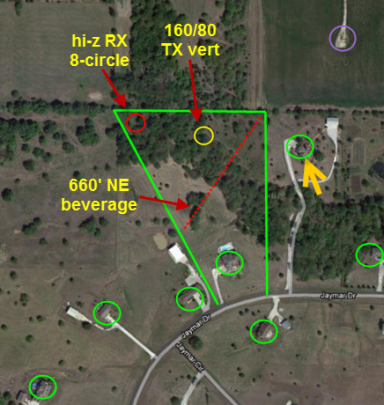
Shown here (right) is a Google map satellite view of the QTH boundaries (green line). Neighbors houses are shown in green circles. The two main receiving antennas are shown in red - the NE beverage (dotted-red line) and the Hi-Z 4-8 pro 8-circle array (red circle). From a contest perspective, things are very quiet. In fact, along the important NE path to Europe, there are no neighbors or other QRN sources for 1-2 miles. The nearest QRN source is the close neighbor, somewhat off axis (yellow thick arrow on right) but fortunately they don't seem to have a plasma television or anything that's really a trouble maker. So far... Off to the NW direction, the QRN level rises from houses about 1/2 mile distant. Swinging back toward the SW and the AU path, we start to catch more close-in neighbors. My closest neighbor is about 300 feet from the back of the NE beverage. The white building at the base of the beverage is his workshop. Fortunately it's not often used. Turning back to the SE path to South America, we point to the cross-street neighbor. 
Looking a bit closer, the map above shows the relative locations of the other shack antennas here at this QTH. While I do have coax notch stub-type filters as well as a set of switched 5B4AGN bandpass filters, I have no damage-level interference with the antenna spacings and very little harmonic interference in that I can operate within a few KHz of the 2nd harmonic of the other rig (So2r operation). The Hi-Z 4-8 pro circle array was a concern given it's an active array and it's 300' distance to the 160m tower. But the Hi-Z guys told me not to worry - and they have been right; the array has been solid since it's installation. When we bought this QTH, my complete lack of experience with outdoor antennas left me completely unprepared to be an adequate judge of a QTH's suitability for receiving antennas. However, we seemed to have got lucky this time and things have worked out pretty well. BEVERAGE: The rest of this page is dedicated to the beverage. HiZ CIRCLE: A separate page is dedicated to the HiZ array. Click HERE. Beverage Old SchoolIn discussions with other hams and on those occasions where I just could not pull a guy out of the mud, I had to wonder - is the HiZ circle really as good as xxxxxx (fill in the blank with your favorite low band antenna). In the end curiosity drove me to put up a beverage allowing me to A-B compare the Hi-Z circle to the beverage. The path the beverage is laid out on can be seen in the maps at the top of the page - look for the red-dotted-line (top map) - or green-dotted-line (bottom map) above. Building the BeverageIn contrast to the high-tech buffered verticals, there is nothing at all magic about a beverage construction. Almost any configuration of any length works to an extent. And that proved to be the case here as well. 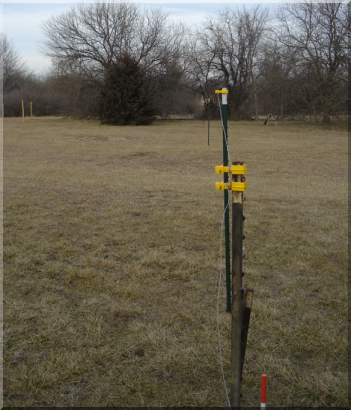
The beverage runs about 660' in length from SW to NE, pointing 42 degrees east of due north. There was nothing special or pre-determined about the length - it happened to be the maximum length of the beverage that I could put along this bearing (it runs from property line to property line extents). It's short of what an ideal 160m length would be, and perhaps a touch long for 80m. Construction is basic, with #14 gauge aluminum fencing wire supported by insulating stand-offs from the fence posts. The beverage is about 5' above ground but varies a few feet over/under as it traverses the ground on it's run. It's more or less straight-ish along the length. The picture (left) provides a view of the beverage looking from the SW end toward the NE. 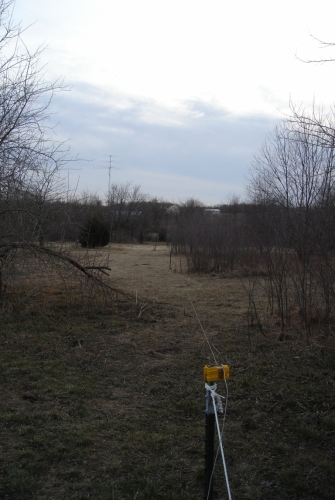
A compromise existing now is that the beverage travels pretty close to the 160m tower, and over the 80m 4SQ. But the beverage was there first, and relocating it was not possible. It still works well despite these nearby verticals. There is a coupling issue, especially with the 80m 4sq pointing in the SW direction. I'm not sure why that is the case but it is. Fortunately the Microham SMD system provides me a relay signal when 1) the beverage is being used for reception, 2) the 80m is pointing in the SE direction **AND** 3) when a 2nd rig is transmitting on 80m. When all 3 are true, then a small attenuator is switched in to reduce the transmit signal level picked up by the beverage and keeping my listening rig safe. The beverage is used on 160m and 80m. At right, looking from the termination end back down the line to the SW. 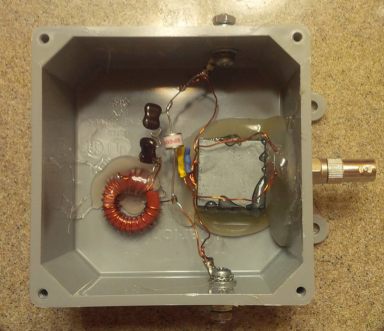
The beverage matching transformer is built out of a huge binocular type 43 core with a 3:9 turns ratio using trifilliar wound #24. Across the beverage wire and ground is a GDT tube to help with lightning, and a 40m notch. The beverage runs near the 40m tower and 40m 4SQ and when using the beverage on 80m the coupling can desense the 80m receiver a bit. The notch on 40m kills that signal and the result is a nice clean 80m band on RX despite having full power 40m transmit antennas nearby. I could have used something more exotic as with the 80m 4SQ issue mentioned above, but this was a quick and simple solution that I knew about at the time I built this transformer box so it was easy to integrate. On the beverage coax run to the shack, a stack of type 31 ferrites and a bunch of turns provides serious common mode clamping. A similar choke is found at the house entrance. Ground connection is made via a set of three 8'-long ground rods spaced on a 4' triangle. 
At the NE termination end of the beverage three 4'-long ground rods are spaced around about a 4-foot triangle. A parallel combination of 2700 ohm 2-watt non-inductive resistors terminates the beverage - about 450 ohms net. A GDT over the resistors keeps them from being blasted by lightning pickup. I also use the beverage for some types of contests where a less directional characteristic is helpful - and for that use a higher resistance termination can be used to degrade the normal back-side rejection. See more on this subject in the modeling section, further down on the page. Modeling the BeverageUsing the ON4UN method of modeling a beverage (resonant legs at the ends of the antenna for the ground side) provides these plots. Assumes 6' fixed height, 470 ohm termination in all cases. 660' beverage - 160m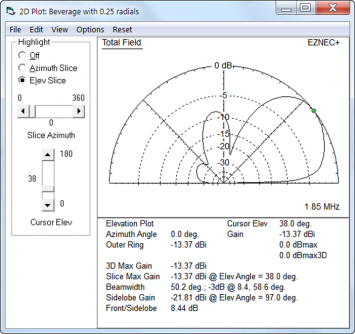
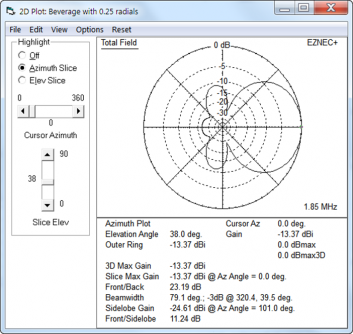
660' beverage - 80m 
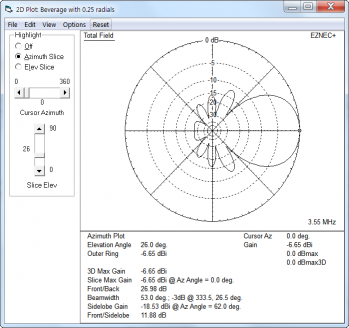
660' beverage - 40m 
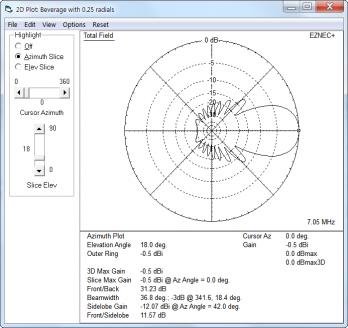
For a given length of beverage, the higher the frequency, the more narrow the beamwidth - as we can see most clearly in the 40m case. It was that reason to keep the direction of the beverage well oriented on Europe. I hoped that it would be a laser beam into EU! Looking at Beverage Termination Values 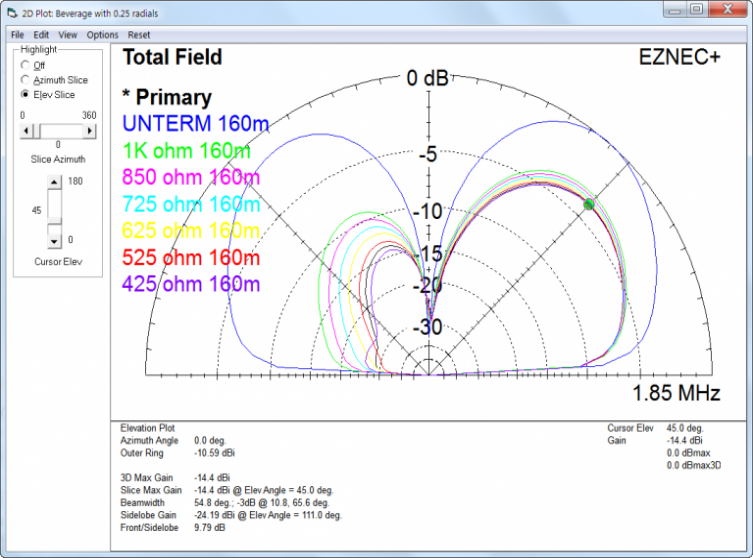
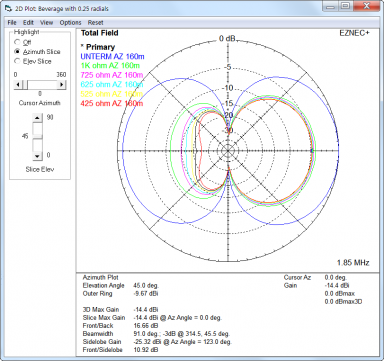
Looking at the graph above, we can see the elevation response with varying terminations. The "normal" termination value is 470 ohms. As the value is raised higher, the antenna becomes less directive along the NE/SW line. I have found that values giving about a 10db F/B (about 525-625 ohms on 160m) work pretty well in practice for domestic contests. As the elevation response increases with increased termination values, so does the azimuth response (left). The antenna never attains a true omni-directional response and this detuned-use has it's limits if you are in need of the off-axis stations. The backside rejection for a given length of beverage is much stronger on 80 and 40, and other values of resistors are more optimum here. Looking at the similar plots below suggests that higher resistance values are needed as the frequency goes up. 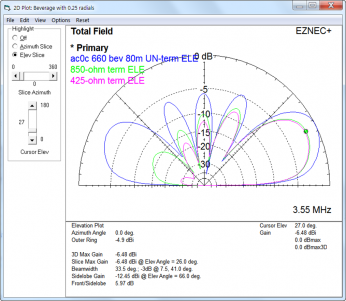
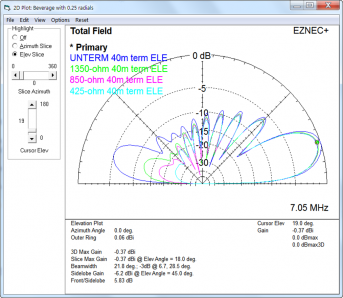
|